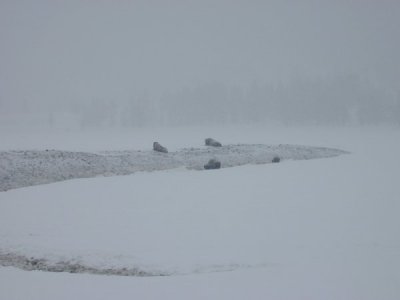Bison Management in Yellowstone Park


Bison (Bison bison)
in Yellowstone National Park have increased in number from around
500 animals in the early 1970ís, to over 3,000 in the early 1990ís.
Three major subpopulations exist, each with discrete summer ranges
but which come together on winter ranges. At higher population
numbers, movements of bison beyond park boundaries during winter
are common. Since Yellowstone bison are known carriers of brucellosis,
these movements are of concern to federal and state agencies in
charge of control or eradication of livestock diseases.
One of the most important issues surrounding
bison is the fact that they carry brucellosis. The potential,
although unlikely, transmission of brucellosis to cattle has generated
a cascade of secondary social facts associated with this. The
potential, harmful consequences to the cattle imply important
economic costs to the ranchers, and to the regional industry.
The States surrounding Yellowstone value all aspects of the cattle
industry because it is their most sustainable resource. Yellowstone
has a potential pool of brucellosis, which the inhabitants of
Montana, and to a lesser degree, Idaho and Wyoming, see as a threat
to their economic interests. Public outcry on this issue skyrocketed
in the winter of 1996-1997 when shooters from Montana Department
of Livestock killed over 1100 buffalo as they wandered outside
Yellowstone National Park in search of food during the severe
winter.
Every political problem has the potential to
create a conflict of jurisdiction between institutions. In this
case, it is federal government, the States and the special interest
groups. In addition to the problem itself (bison brucellosis),
there is a battleground where weaker actors (like the States)
put pressure over more powerful ones (like the federal government)
with whom they have a long confrontational history.
Each economic conflict mobilizes actors in the
political arena. Every interest lobbies in order to reach a favorable
position, using politics to do so. This political arena is the
playground where federal government, States government, agencies
and environmental groups deal with their differences. Overall,
the bison and brucellosis issue is a biological fact affecting
all economic, social and political arenas.
Management of brucellosis in bison could potentially be complicated
by transmission of the disease between elk and bison. Scientists
from Montana State University are assessing the potential for
such interspecies disease transmissions in the Madison-Firehole
area of YNP. This area was selected because it is the major wintering
ground for approximately 1000 bison as well as and estimated 600-800
nonmigratory elk